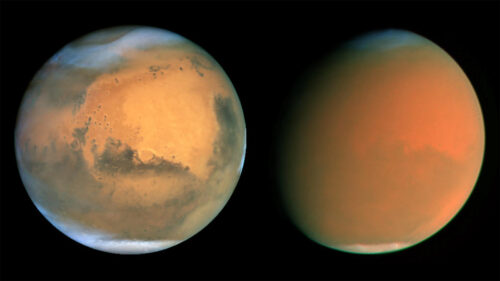Image courtesy of NASA.
Scientists have long been interested in predicting weather on Earth, but in recent decades, tools developed for climate science at home have increasingly been applied to studies of extraterrestrial atmospheres. Inspired by puzzling patterns in Martian dust storms, researchers at Yale recently investigated the effects of annular modes of variability—climate patterns that repeat every few weeks to a month, independently of the cycle of seasons—on Mars and Titan, a moon of Saturn.
Joseph Michael Battalio, a postdoctoral associate in Yale’s Department of Earth and Planetary Sciences, noticed a few years ago that certain patterns of Martian dust activity seemed to repeat approximately every twenty sols (Martian days). This length of time didn’t match the behavior of any known Martian storm instigator but was quite similar to that of the annular modes Battalio had previously studied on Earth. This led him to look for the effects of these modes on Mars.
Supporting this hypothesis, Mars has many other atmospheric similarities to Earth: it rotates at a nearly identical speed (one sol is approximately twenty-four hours and thirty-nine minutes) and exhibits similar prevailing winds.
When Battalio began analyzing data from Mars, fluctuations in atmospheric eddy kinetic energy—a quantity associated with storms—and shifts in atmospheric mass showed cyclic behavior that was clearly due to annular modes.
Similar results were also found on Titan, the largest moon of Saturn and a body of particular interest due to stable liquids and hydrocarbons on its surface. The moon is studied via the Titan Atmospheric Model (TAM), a numerical climate model created by Yale professor Juan Lora. “TAM enables us to generate realistic simulations of Titan’s global circulation,” Battalio said. These pronounced effects of annular modes on Mars and Titan may suggest the ubiquity of annular modes in terrestrial atmospheres.
This research makes great contributions to our understanding of extraterrestrial atmospheric dynamics and may aid our exploration of Mars. Martian dust storms are notoriously brutal, and occasionally prove lethal to solar-powered missions, but this research could help protect future landers. “[Annular modes on Mars] impact the overall climate and dust storm activity… [and] Mars’s modes may even enable us to generate predictions of dust activity,” Battalio said. Activity from annular modes on Mars tends to reliably foreshadow dust activity, so accurate current observations of the atmosphere allow prediction of storms in a few days’ time.
Looking forward, Battalio has received a grant from NASA to continue investigating atmospheric variations on planets and moons. He plans to look further into modes on Mars and Titan, particularly as they relate to weather events. For instance, Titan’s methane storms are currently not well understood, but they pose a potential hazard to future landers such as NASA’s Dragonfly. Other bodies, such as Venus—which has atmospheric patterns similar to Titan’s—and Jupiter are also on the docket. Finally, his research into annular modes could prove useful to the study of exoplanets, helping to provide baseline atmospheric understanding so that more irregular winds can be spotted.
Battalio and Lora have broken new ground in extraterrestrial atmospheric science, and their work has countless applications—on Earth, in our solar neighborhood, and lightyears away.

